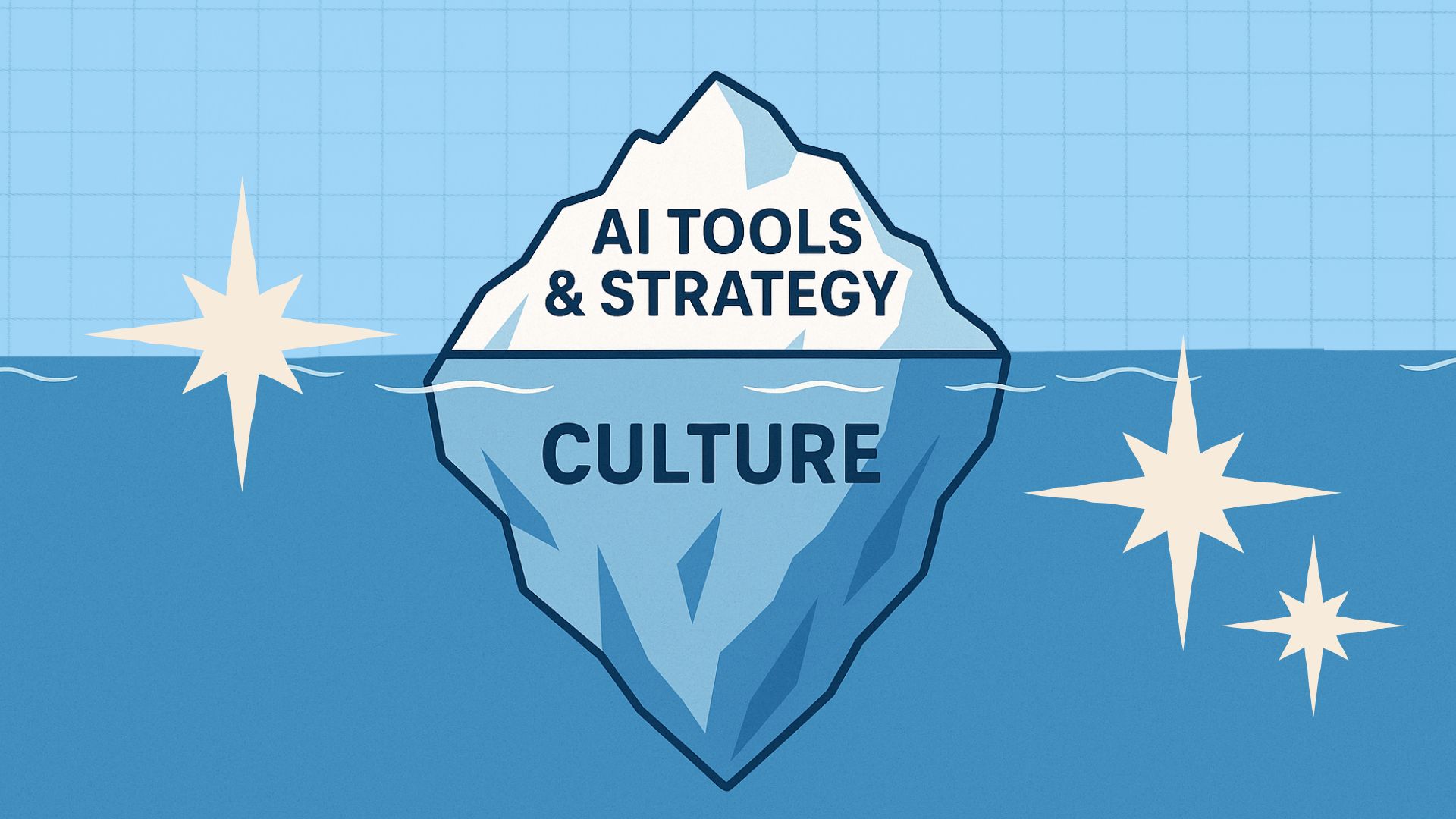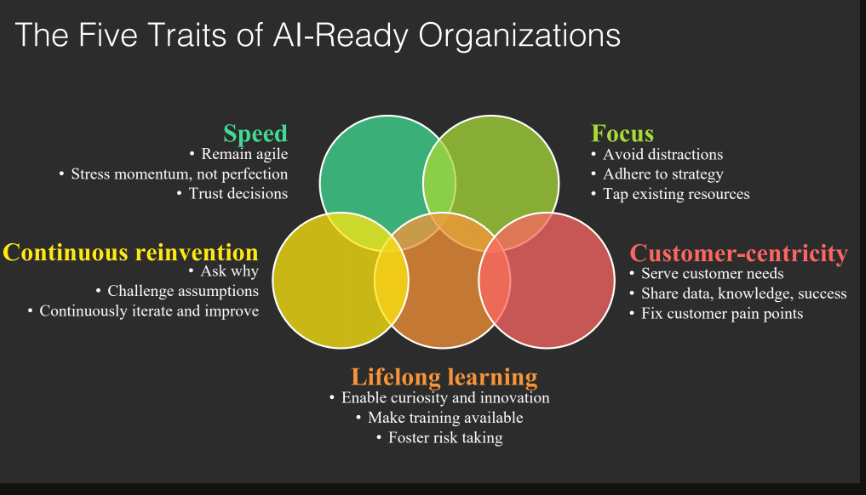- Leading Disruption
- Posts
- Are You Building an AI-Ready Culture?
Are You Building an AI-Ready Culture?

The best-laid plans for AI adoption are meaningless if the culture isn’t ready. It’s a problem that leaders worldwide are grappling with.
How can we encourage our teams to adopt AI if they’re not yet ready for it?
I have just wrapped up my travels in London and Singapore, meeting with organizations that are tackling AI adoption—or, as I call it, AI adaptation. Because here's the truth: AI isn't just another technology rollout. It challenges our identities, triggers existential questions about how we create value, and occurs at a pace that can leave people feeling overwhelmed.
Traditional change management doesn't work here. We can't map out a fixed future because AI keeps evolving. We can't manage resistance when people are grappling with change fatigue and uncertainty about their roles.
So what does work?
The Five Traits of AI-Ready Organizations
My co-author, Katia Walsh, and I have worked with companies around the world (including one 100-year-old multinational energy company that successfully transformed its entire culture). In our upcoming book “Winning with AI: The 90 Day Blueprint for Success,” we've identified five critical traits that separate organizations thriving with AI from those struggling with it.
1️⃣ Speed
To quote Vikram Mahidhar, a fellow AI thought leader, “speed is the new moat.” It's how you create competitive advantage in the AI era.
This means choosing iteration over perfection. Being able to make decisions quickly and to use AI to gather and process significantly more information. It also means that you trust your team to make sensible choices (because they're aligned on strategy, values, and purpose), so that speed becomes possible.
Organizations that wait for the “perfect moment” often find themselves left behind as AI continues to develop rapidly.
2️⃣ Focus
The good news about AI? You can do so much with it.
The bad news? You can do so much with it.
Focus means directing AI toward your most strategic organizational priorities. Not creating endless lists of use cases, but making tough choices about what matters most. Use existing budgets to force discipline: if you're taking on AI, what will you have to stop doing?
We recommend the "Double-S Matrix" for prioritization, which balances two key metrics:
🔸 Size of value
🔸 Speed to value
Go after what creates the most impact, not what's easiest.
3️⃣ Continuous Reinvention
Organizations that constantly ask "why?" or "why not?" build this trait naturally. They challenge assumptions and the status quo, reveal inconsistencies between what they say and what they do, and regularly examine whether their metrics actually measure success or just what's easy to track.
For example, could you use AI to develop predictive customer satisfaction indicators instead of relying on lagging complaint volumes? That's continuous reinvention in action.
4️⃣ Lifelong Learning
With AI constantly evolving, learning can never be “one-and-done.” Build an environment that normalizes not knowing. Leaders need to model curiosity and a willingness to learn.
Make reflection a habit—build it into debriefs, one-on-ones, and regular reviews. Reward curiosity over certainty. One organization we know made continuous learning a promotion criterion, requiring leaders to document how they're advancing their development each quarter.
5️⃣ Customer Centricity
Ensure your customer journeys span departments. Marketing's AI tools should integrate with sales' and customer service's tools, using the same data and insights.
Tie everything back to unified metrics of customer success and build those "walkways between silos" for collaboration.

A Top-Down Approach
Here's what separates successful AI transformations from failed ones: a clear CEO mandate.
Companies like Shopify, Box, and more have made their vision for the future clear:
"Everyone will become AI fluent. We'll support you with tools and training, but this is an expectation."
An effective CEO mandate includes three elements:
Imperative: Driving adoption and AI fluency across the organization
Enforcement: Performance mechanisms and clear timelines
Definition: What does "AI fluent" look like in your organization, by role?
This approach is about giving people permission to take time to learn new ways of working.
Cultural Leadership is a Long-Term Project
I wish I could hand you a simple formula: mix these ingredients, follow these steps, bake at 350 degrees, and you're done. But cultural change doesn't work that way.
These five traits—speed, focus, continuous reinvention, lifelong learning, and customer centricity—aren't a checklist. They're interconnected qualities that reinforce each other. When you build trust through alignment, you enable speed. When you normalize learning, you enable continuous reinvention.
The key is to start somewhere and stay committed to the work.
🎤 Your Turn
What changes are you making to build an AI-ready culture? What's working—and what isn't?
What I Can’t Stop Talking About
Leaders who think they’ve got it all figured out are setting their organizations up for failure. The best AI leaders have one key thing in common: they’re asking the right questions.
Who should run your AI pilots? If you said “IT,” think again. Organizations that place AI under the HR umbrella may be more successful than those that treat it as just another piece of technology.
Have you listened to my DEX episode yet? I enjoyed discussing how to make AI work effectively for organizations of all sizes. Take a listen here.
I’ll be appearing on the Process Transformers Podcast on October 14! Join me as we discuss tracking your AI success, aligning strategic priorities, and scaling pilots.
My Upcoming Appearances/Travel
Oct 15: Executive Women's Forum, Keynote, Denver, CO
Oct 21: Calix ConneXions 2025, Las Vegas, NV
Nov 12: Private Client, Santa Barbara, CA
Nov 13: Brilliance 2025, Celebrating Women Disrupting Healthcare Keynote, Chicago, IL

If you found this note helpful, please forward and share it with someone who needs the inspiration today. If you were forwarded this, please consider subscribing.